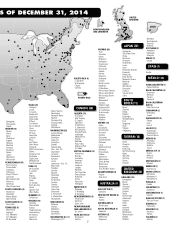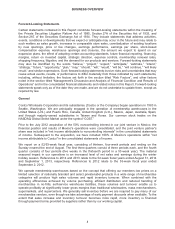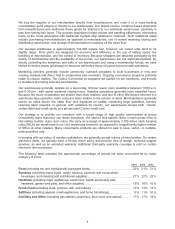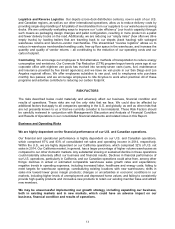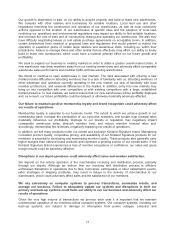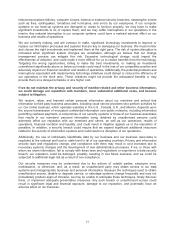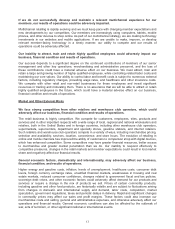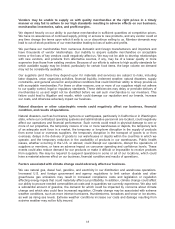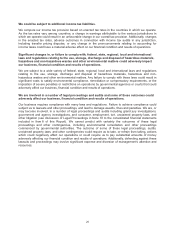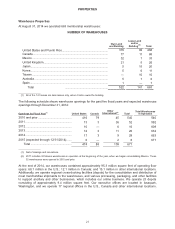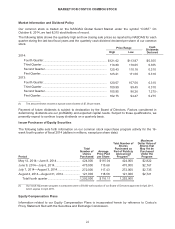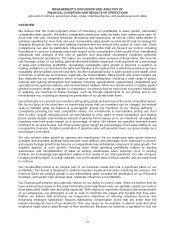Costco 2014 Annual Report Download - page 19
Download and view the complete annual report
Please find page 19 of the 2014 Costco annual report below. You can navigate through the pages in the report by either clicking on the pages listed below, or by using the keyword search tool below to find specific information within the annual report.
If we do not successfully develop and maintain a relevant multichannel experience for our
members, our results of operations could be adversely impacted.
Multichannel retailing is rapidly evolving and we must keep pace with changing member expectations and
new developments by our competitors. Our members are increasingly using computers, tablets, mobile
phones, and other devices to shop online. As part of our multichannel strategy, we are making technology
investments in our websites and mobile applications. If we are unable to make, improve, or develop
relevant member-facing technology in a timely manner, our ability to compete and our results of
operations could be adversely affected.
Our inability to attract, train and retain highly qualified employees could adversely impact our
business, financial condition and results of operations.
Our success depends to a significant degree on the continued contributions of members of our senior
management and other key operations, merchandising and administrative personnel, and the loss of
these contributions could have a material adverse effect on our business. We must attract, train and
retain a large and growing number of highly qualified employees, while controlling related labor costs and
maintaining our core values. Our ability to control labor and benefit costs is subject to numerous external
factors, including regulatory changes, prevailing wage rates, and healthcare and other insurance costs.
We compete with other retail and non-retail businesses for these employees and invest significant
resources in training and motivating them. There is no assurance that we will be able to attract or retain
highly qualified employees in the future, which could have a material adverse effect on our business,
financial condition and results of operations.
Market and Other External Risks
We face strong competition from other retailers and warehouse club operators, which could
adversely affect our business, financial condition and results of operations.
The retail business is highly competitive. We compete for customers, employees, sites, products and
services and in other important respects with a wide range of local, regional and national wholesalers and
retailers, both in the United States and in foreign countries, including other warehouse club operators,
supermarkets, supercenters, department and specialty stores, gasoline stations, and internet retailers.
Such retailers and warehouse club operators compete in a variety of ways, including merchandise pricing,
selection and availability, services, location, convenience, and store hours. The evolution of retailing in
online and mobile channels has improved the ability of customers to comparison shop with digital devices,
which has enhanced competition. Some competitors may have greater financial resources, better access
to merchandise and greater market penetration than we do. Our inability to respond effectively to
competitive pressures, changes in the retail markets and member expectations could result in lost market
share and negatively affect our financial results.
General economic factors, domestically and internationally, may adversely affect our business,
financial condition, and results of operations.
Higher energy and gasoline costs, inflation, levels of unemployment, healthcare costs, consumer debt
levels, foreign currency exchange rates, unsettled financial markets, weaknesses in housing and real
estate markets, reduced consumer confidence, changes related to government fiscal and tax policies,
sovereign debt crises, and other economic factors could adversely affect demand for our products and
services or require a change in the mix of products we sell. Prices of certain commodity products,
including gasoline and other food products, are historically volatile and are subject to fluctuations arising
from changes in domestic and international supply and demand, labor costs, competition, market
speculation, government regulations, taxes and periodic delays in delivery. Rapid and significant changes
in commodity prices may affect our sales and profit margins. These factors could also increase our
merchandise costs and selling, general and administrative expenses, and otherwise adversely affect our
operations and financial results. General economic conditions can also be affected by the outbreak of
war, acts of terrorism, or other significant national or international events.
17


